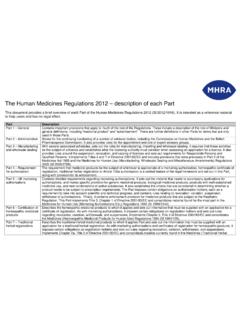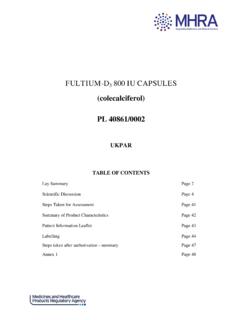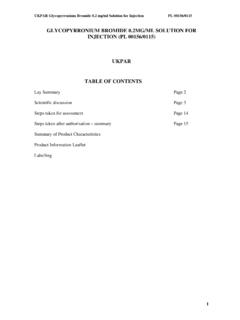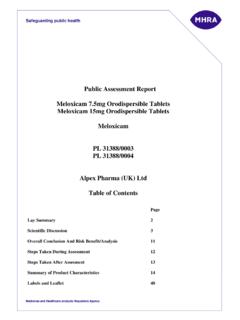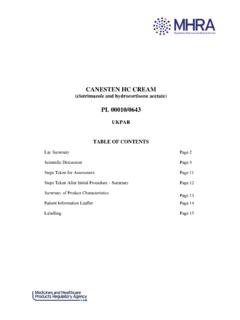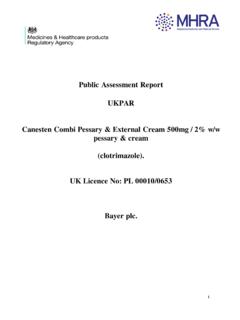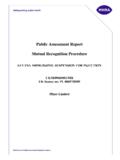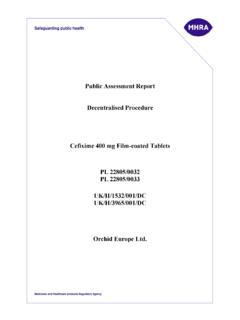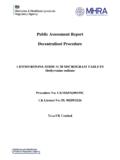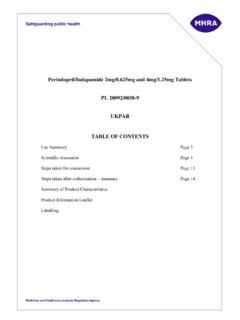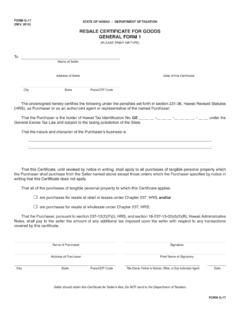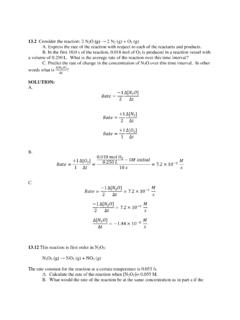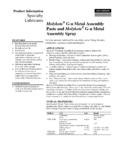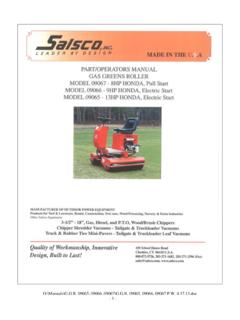Transcription of DCPAR for Ampicillin-Salbactam 1 g--0 5 and 2 g-1 …
1 PAR Ampicillin/Sulbactam 1 g and 2 g/1 g powder for Solution for Injection or Infusion UK/H/4322/001-2/DC 1 Public Assessment Report Decentralised Procedure Ampicillin/Sulbactam 1 g and 2 g/1 g Powder for Solution for Injection or Infusion Ampicillin sodium and Sulbactam sodium UK/H/4322/001-2/DC UK licence no: PL 28176/0047-8 Strides Arcolab International Limited PAR Ampicillin/Sulbactam 1 g and 2 g/1 g powder for Solution for Injection or Infusion UK/H/4322/001-2/DC 2 Ampicillin/Sulbactam 1 g and 2 g/1 g Powder for Solution for Injection or Infusion PL 28176/0047-8 LAY SUMMARY On 24th May 2012, Austria, Bulgaria, Czech Republic, Germany, Italy, Poland, Slovak Republic and the United Kingdom agreed to grant marketing authorisations to Strides Arcolab International Limited for medicinal products Ampicillin/Sulbactam 1 g and 2 g/1 g Powder for Solution for Injection or Infusion.
2 The marketing authorisations were granted via the Decentralised Procedures (DCP), with the UK as Reference Member State (RMS). After the national phase, licences were granted in the UK on 2nd July 2012. Ampicillin/Sulbactam is an antibiotic and works by killing bacteria that cause infections. It contains two different medicines called ampicillin and sulbactam. Ampicillin belongs to a group of medicines called penicillins and sulbactam belongs to a group of medicines called beta-lactam inhibitors . Ampicillin/Sulbactam is used in adults and children to treat the following - Pneumonia - Kidney infections - Intra-abdominal infections - Genital organ infection in women - Skin and soft tissues infections Ampicillin / Sulbactam is used to prevent infections associated with abdominal infections.
3 No new or unexpected safety concerns arose from these applications and it was, therefore, judged that the benefits of taking Ampicillin/Sulbactam 1 g and 2 g/1 g Powder for Solution for Injection or Infusion outweigh the risks, hence Marketing Authorisations have been granted. PAR Ampicillin/Sulbactam 1 g and 2 g/1 g powder for Solution for Injection or Infusion UK/H/4322/001-2/DC 3 TABLE OF CONTENTS Module 1: Information about initial procedure Page 3 Module 2: Summary of Product Characteristics Page 5 Module 3: Product Information Leaflets Page 28 Module 4: Labelling Page 32 Module 5.
4 Scientific Discussion Page 35 1 Introduction 2 Quality aspects 3 Non-clinical aspects 4 Clinical aspects 5 Overall conclusions Module 6 Steps taken after initial procedure PAR Ampicillin/Sulbactam 1 g and 2 g/1 g powder for Solution for Injection or Infusion UK/H/4322/001-2/DC 4 Module 1 Product Name Ampicillin/Sulbactam 1 g and 2 g/1 g Powder for Solution for Injection or Infusion Type of Application Generic application, Article Active Substance Ampicillin sodium Sulbactam sodium Form Powder for Solution for Injection or Infusion Strength 1 g or 2 g Ampicillin Sodium or 1 g Sulbactam sodium MA Holder Strides Arcolab International Limited, Unit 4, Metro Centre, Tolpits Lane, Watford, Hertfordshire, WD 189 SS, UK RMS UK CMSs Austria, Bulgaria, Czech Republic, Germany, Italy, Poland and Slovak Republic Procedure Number UK/H/4322/001-2/DC Timetable Day 210.
5 24th May 2012 PAR Ampicillin/Sulbactam 1 g and 2 g/1 g powder for Solution for Injection or Infusion UK/H/4322/001-2/DC 5 Module 2 Summary of Product Characteristics 1 NAME OF THE MEDICINAL PRODUCT Ampicillin / Sulbactam 1 g Powder for solution for injection or infusion 2 QUALITATIVE AND QUANTITATIVE COMPOSITION Active substances: sulbactam sodium, ampicillin sodium Ampicillin / Sulbactam 1 g: Each vial with 1610 mg powder contains 547 mg sulbactam sodium, equivalent to g sulbactam, and 1063 mg ampicillin sodium, equivalent to 1 g ampicillin. Excipient: 5 mmol (115 mg) of sodium/vial of powder for solution for injection or infusion.
6 For the full list of excipients, see section 3 PHARMACEUTICAL FORM Powder for solution for injection or infusion White to off-white powder 4 CLINICAL PARTICULARS Therapeutic indications Ampicillin / Sulbactam is indicated in the treatment of the following - community acquired pneumonia - upper urinary tract infection - intra-abdominal infections - gynaecological infections (see section ) - skin and soft tissues infections - Prophylaxis against infections associated with abdominal surgery.
7 Consideration should be given to official guidance on the appropriate use of antibacterial agents. Posology and method of administration Posology The recommended dose for adults is 3 to 12 g Ampicillin / Sulbactam depending on the severity of the infection divided into equal single doses every 6 to 8 hours. Paediatric patients: For children over 2 years the recommended dose is 150 mg/kg/day (ampicillin 100 mg/kg/day + sulbactam 50 mg/kg/day). The therapeutic dosage should be given in three or four divided doses. The intramuscular application should not be given in newborn infants, infants and toddlers (below 2 years).
8 Ampicillin / Sulbactam should be given exclusively by intravenous use according to the following indications: - For newborn infants above the second living week, infants and toddlers till 2 years the recommended dose is 150 mg/kg/day (ampicillin 100 mg/kg/day + sulbactam 50 mg/kg/day). The therapeutic dosage should be given in three or four divided doses. - For newborn infants in the first living-week the recommended dose is 75 mg/kg /day (equivalent to ampicillin 50 mg/kg/day plus sulbactam 25 mg/kg/day). The therapeutic dosage should be given in two divided doses. Use in the Elderly: Ampicillin / Sulbactam injection may be administered in the elderly in the usual dosages with no special precautions.
9 Prophylaxis of surgical infections: - 3g of Ampicillin / Sulbactam injection should be given at induction of anaesthesia, which allows time to achieve effective serum and tissue concentrations during the procedure. In case of long-term surgery another dose in 3-4 hours may be administered. Administration of Ampicillin / Sulbactam is usually stopped 24 hours after the majority of surgical procedures unless a therapeutic course of is indicated. PAR Ampicillin/Sulbactam 1 g and 2 g/1 g powder for Solution for Injection or Infusion UK/H/4322/001-2/DC 6 Use in patients with renal impairment: In patients with severe renal impairment (creatinine clearance < 30ml/min) the elimination kinetics of sulbactam and ampicillin are similarly affected and hence the plasma ratio of one to the other will remain constant whatever the renal function is.
10 The dose of Ampicillin / Sulbactam in such patients should be administered less frequently in accordance with the usual practice for ampicillin. Recommended dosages for patients with impaired renal function: Creatinine clearance (ml / min) Dose interval >30 15 to 30 5 to 14 <5 6 to 8 hours 12 hours 24 hours 48 hours Sulbactam and ampicillin are both eliminated from the blood stream to an equal extent by hemodialysis treatment. Ampicillin / Sulbactam should therefore be administered immediately after dialysis and then at 48 hour intervals until the following dialysis treatment. Use in patients with hepatic impairment: Usual recommended doses.
